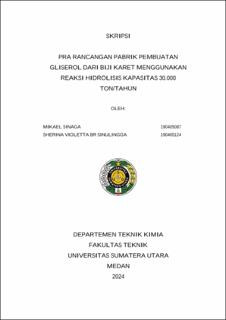Pra Rancangan Pabrik Pembuatan Gliserol dari Biji Karet Menggunakan Reaksi Hidrolisis Kapasitas 30.000 Ton/Tahun
Preliminary Design of Glycerol Manufacture from Rubber Seeds Uses Hydrolysis Reaction with a Capacity 30,000 Tons/Year

Date
2024Author
Sinaga, Mikael
Sinulingga, Sherina Violetta Br
Advisor(s)
Sarah, Maya
Bani, Okta
Metadata
Show full item recordAbstract
Glycerol is a chemical that has various uses in the pharmaceutical, cosmetic and food industries. Glycerol is obtained through various processes. Glycerol can be produced as a by-product of saponification and hydrolysis reactions in oleochemical plants and transesterification reactions in biodiesel plants. The main objective of this factory design is to implement chemical engineering disciplines and provide initial information in designing a hydrochloric acid manufacturing plant. Pre-design of a factory for making glycerol from rubber seeds using a hydrolysis reaction with a production capacity of 30,000 tons/year. The main process in factory design consists of 3 stages, namely the raw material preparation stage, the reaction (hydrolysis) stage and the product purification stage. This glycerol factory is planned to be established in Kec. Dolok Merawan, Serdang Bedagai Regency, North Sumatra with a land area of 16,540 m2. The factory operates 24 hours per day, 330 working days per year with 300 employees. The form of business entity at this glycerol factory is a Limited Liability Company (PT). To establish and operate the factory requires investment capital of IDR 158,423,697,913 and production costs of IDR 1,505,922,755,283. Based on the feasibility analysis, this factory has a BEP of 27.33%, ROI of 20.64%, POT of 4.84 years, RON of 34.40% and IRR of 24.34%. From the results of the economic analysis, it can be concluded that the design of a factory for making glycerol from rubber seeds using a hydrolysis reaction is feasible to establish.
Collections
- Undergraduate Theses [1239]
